Here’s the world’s easiest True or False quiz:
People buy more from salespersons they trust.
- True
- False
If you answered A (and you did), congratulations, you are in great company. According to Marketo, leads who trust their salespersons make up to 47% larger purchases. Naturally, the best salespeople build trust by demonstrating their understanding of the customer's unique challenges and needs.
This “trust first, sell later” sales philosophy has led to a highly effective, research-backed framework focused on building and nurturing long-term relationships. Called SPIN Selling, it can make you into a bonafide sales superhero.
Table of Contents:
- What is SPIN selling?
- Why do organizations use SPIN selling?
- SPIN Selling: Unpacking the acronym and example questions
- A (short) history of SPIN Selling
- The four stages of a SPIN Selling
- The 4 possible outcomes of SPIN selling (based on the book)
- When is SPIN selling the right framework for your business?
- How Clari Copilot helps you implement SPIN sales
What is SPIN selling?
SPIN selling or SPIN Sales is a consultative selling technique and one of the leading sales methodologies. The term comes from one of the leading sales books written by Neil Rackham — founder of Huthwaite International — in the 1980s, based on his study of more than 35,000 sales calls that disproved a lot of the commonly held beliefs of traditional sales methods — especially when it came to selling high-value items.
Rather than introducing your product immediately, SPIN selling encourages sales reps to develop a deep understanding of their customers’ needs. You do this by asking the right questions at the right moment and actively listening to the prospect’s answers.
Why do organizations use SPIN selling?
There are several reasons organizations use the SPIN selling method:
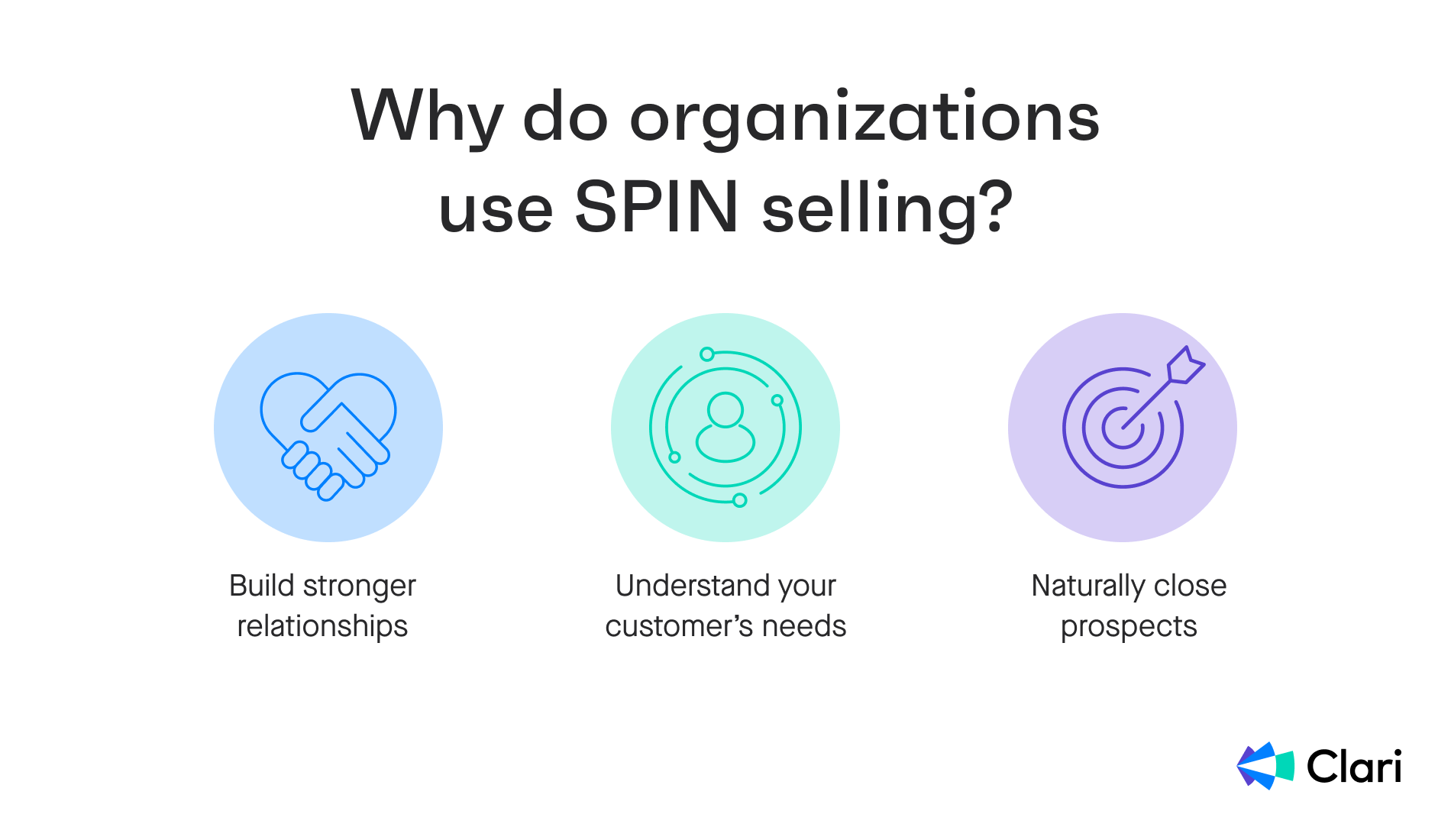
- Build stronger relationships. When using the SPIN selling methodology, successful salespeople are seen as consultants, not salespeople. The technique focuses on building stronger conversations, which builds trust and should result in more sales. It should also result in stronger customer loyalty and more referrals.
- Understand your customer’s needs. SPIN selling forces reps to pose unique and thought-provoking questions to determine what prospects need from a solution. This makes it much easier to pitch your product as the solution they need by highlighting how it can solve their pain points.
- Naturally close prospects. With SPIN selling, reps don’t have to “always be closing.” Rather than constantly pressing for the sale and coming across as a pushy sales rep, deals should occur naturally if the prospect has a genuine need. Prospects should have fewer objections, too.
SPIN Selling: Unpacking the acronym and example questions
The SPIN Selling framework gets its name from the first letter of each of the four types of SPIN questions that the framework recommends salespeople use:
S - Situations
P - Problems
I - Implications
N - Need-Payoff
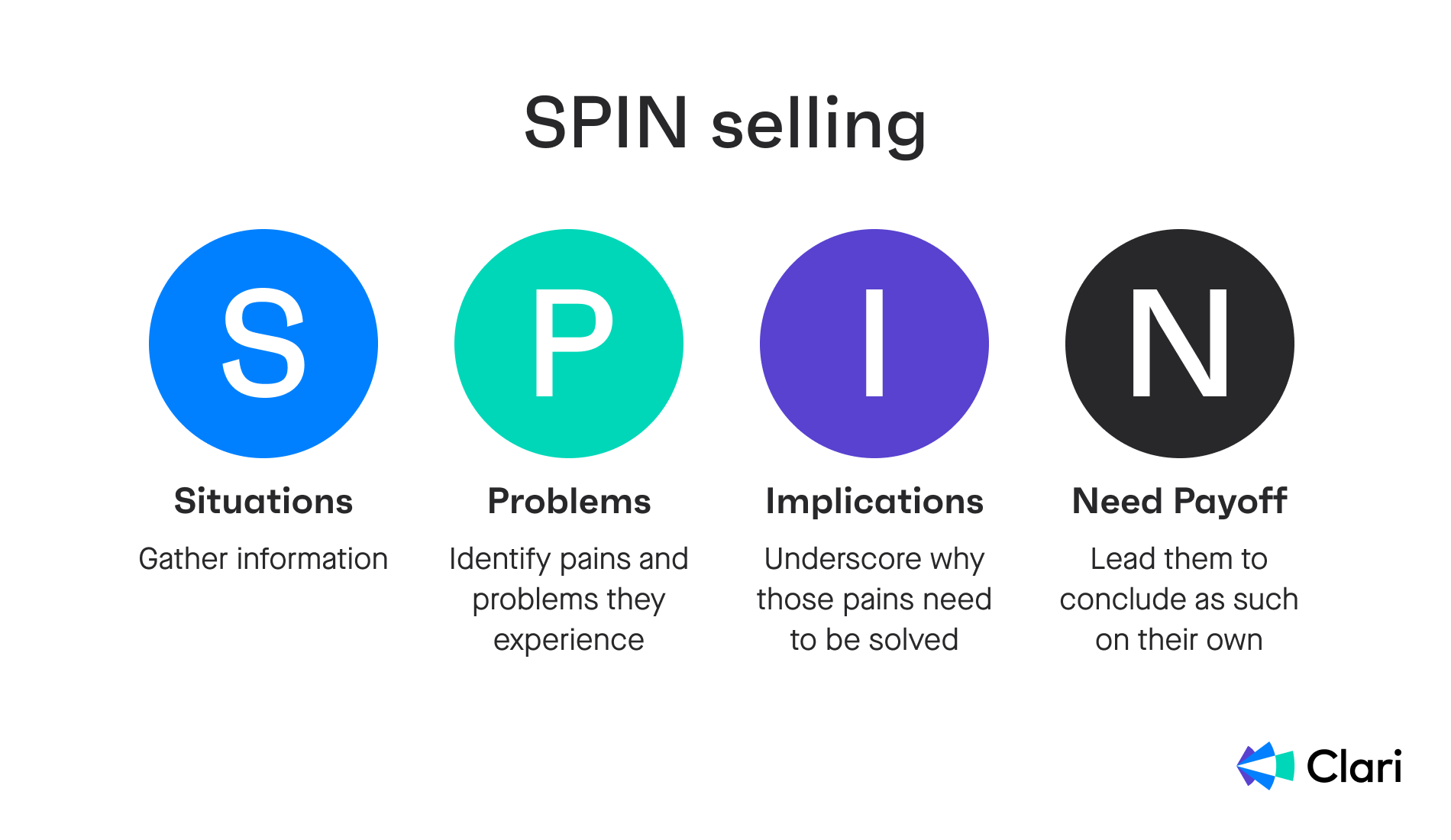
Let’s dive a little deeper:
1. Situations
Situational questions can help you understand your customer's current situation and concerns. The goal is to gather details about the buyer’s existing circumstances. You can kick off the conversation by asking situation questions like:
- How much do you spend on data security?
- What tools do you use?
- How would you describe your current sales process?
2. Problems
Problem questions focus on the challenges that prospects face in their current circumstances. Be thorough, but don’t fall into the trap of asking endless Problem questions. Ask questions such as:
- Are you satisfied with your content marketing efforts?
- How easy is it to convert leads?
- Do your processes end up creating problems of their own?
3. Implications
Once you've identified your client's biggest hurdles, it's time to analyze their implications. Remember, this is not the time to talk about your product — it’s still about the buyer’s needs and concerns. You need to cement the fact that the cost of the problem is far greater than that of the solution. For example:
- How does it affect your business when your sales teams are overwhelmed by high sales volume?
- How much time and money does your operation lose if your software crashes?
- How much does it cost to back up your data every week?
4. Need-Payoff
You just sparked action by having prospects identify the risks of staying the course. Now you introduce your solution in the form of Need-Payoff questions and enable them to take action upon realizing the significance of your proposal.
Here are some examples of Need-Payoff questions:
- Do you think your sales teams could benefit from this automated system?
- Would it be desirable if your automated processes were capable of connecting sales and marketing?
- How much could you save in cost and man-hours with this automated data backup solution?
A (short) history of SPIN Selling
This sales technique was developed in 1988 when Neil Rackham, psychologist and founder of Huthwaite, reviewed about 35,000 successful sales calls and found that the best performers did something distinctly different . They utilized open-ended questions and active listening to discover customer frustrations, worries, struggles, and desires.
That same year, Rackham turned his findings into a bestselling book: SPIN Selling.
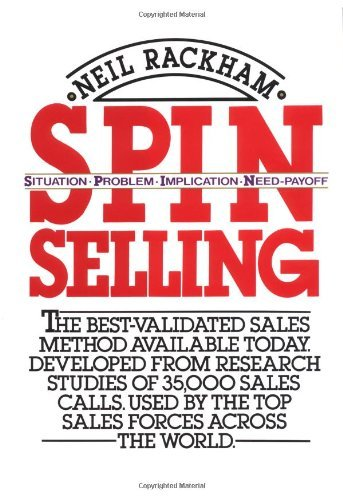
In SPIN Selling, Rackham explains that the goal is not to pitch your product as early in the sales process as possible. Instead, it asks salespersons to first build value as trusted advisors, ask the right types of questions, and get the conversation going.
Of course, this is easier said than done. Because SPIN sales take time, effort, and patience, it’s best suited for complex, high-value and major sales, larger sales cycles, and a multi-platform buyer’s experience.
“Most salespeople are half prepared. They know everything about their company and their product. They know nothing about their prospect.”
Jeffrey Gitomer
A lot has changed in the 30+ years since SPIN Selling was introduced to the world. Social media and the internet have made it so much easier to research prospects—especially details like turnover and team size. The smarter sales folks now skip over a lot of the Situation questions and Problem questions with some hardcore research.
Situation questions have value only for you and not for the prospect. So, the less time you spend on them, the better.
Problem questions can be tackled by going through the social channels and using tools like ProductHunt or Capterra. If there are any company-related forums, make sure to browse through those, too, to find out what the current product/service landscape is.
Spending time on research not only allows you to get to the juicy part quickly, where you can start closing the deal, but it also shows your prospect how serious and thorough you are—two traits every company would appreciate in their vendor.
The four stages of a SPIN Selling
In his book, Rackham outlines the four basic stages of every sale. Let’s understand each one with the example of closing a deal for one of your customer-facing insurtech solutions.
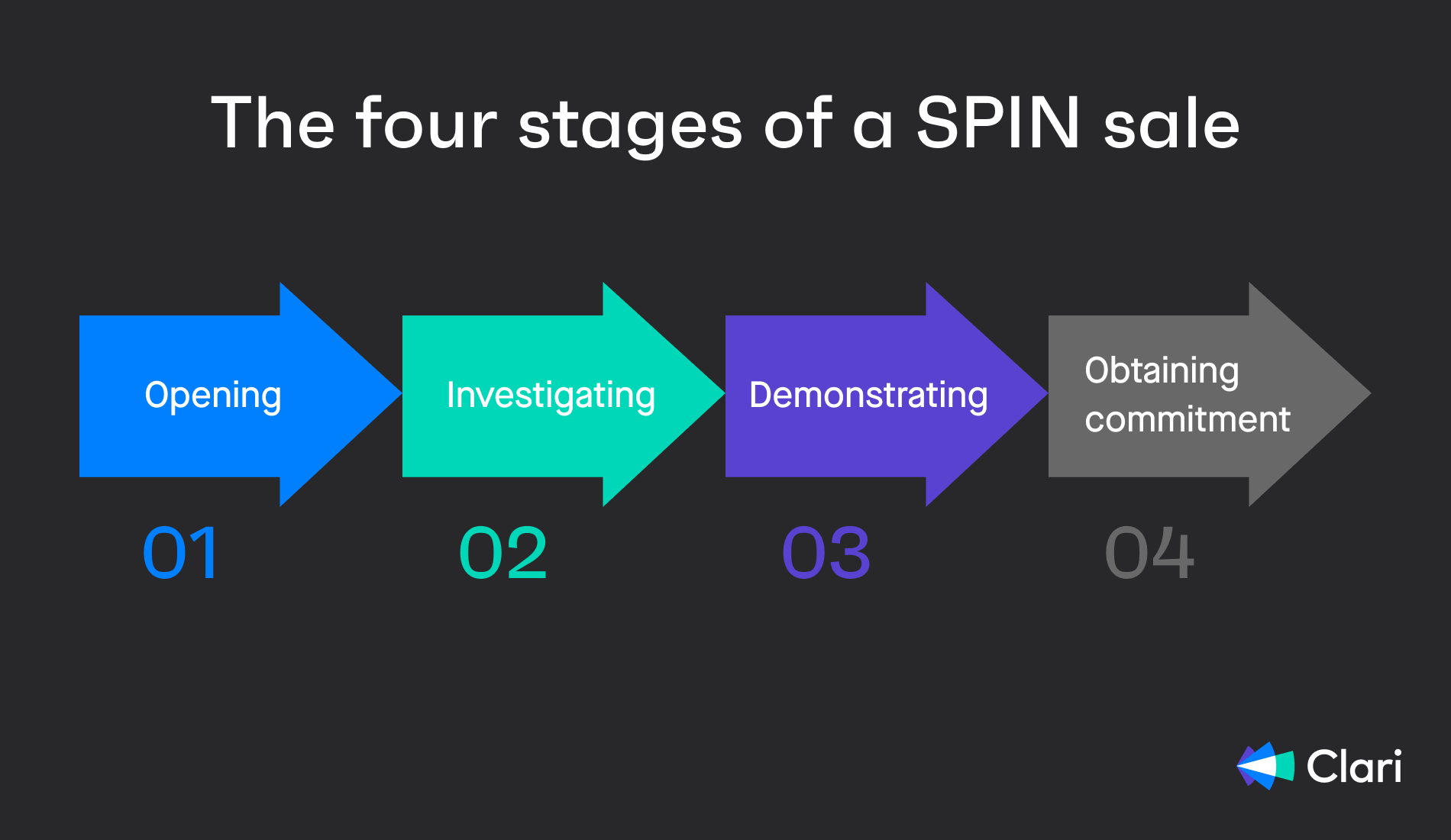
Opening
This is often the introductory connect call, where you focus on building rapport. Instead of talking about your product, which would lead to missing out on valuable information, ask questions and respond with compelling insights or other intelligent questions. Keep all your research material handy to ensure that you establish trust. Generic questions like the following would be best to ask here:
- What is your company’s stance on using technology for internal and external insurance processes? Why is it so?
- What systems and processes do you currently use for serving customers?
- Can you walk me through your complete customer funnel?
- How long have you used this funnel sequence?
- Have you gauged your NPS? What is it?
Investigating
This is the most critical stage of the process, where the focus is on figuring out what problems the prospect is facing, understanding their priorities and purchase criteria, and building trust and credibility by reassuring them you have their best interests at heart. Pull out those Problem and Implication questions!
- Are customers easily moving from one stage of the funnel to the next?
- Are they engaging and responding as much as you’d like?
- Have you witnessed a rise or fall in customer engagement and satisfaction in your competitors based on their level of technological use? Has their technological adoption affected your customer base?
- Do your processes and systems end up creating problems of their own?
- What’s the net profit percentage from these systems and processes?
Demonstrating
At this stage, you know your product can help solve the problem, and you need to convey this information to the buyer. Lead with the Need-Payoff Questions and branch into demonstrating how your product is the perfect solution for their problem.
- If customers easily moved from one stage of the funnel to the next, would that significantly save up on costs for your company?
- Would higher customer response and satisfaction encourage your marketing team to craft high-level campaigns that circle back more response and satisfaction?
- Would it help if the problems created by your problems and systems could be reduced by even 20%?
Now that you have opened up possibilities through a simple question, use the FAB technique (Features, Advantages, and Benefits) to highlight your solution. The core template is ‘Because our solution has [feature], it can [advantage it provides] which allows you to [benefit].’
However, SPIN is all about customization. Instead of a laundry list of use cases, show your prospects how the product solves the unique problems they uncovered during the investigation stage.
Obtaining commitment
In simpler sales cycles, this stage arrives fairly quickly and has a straightforward conclusion: either the prospect agrees to buy or they walk away. In complex sales, however, cycles may run for years. So the conclusion may not always be a yes or no. Anything that does not lead to a “no” is a positive step towards the final yes. The prospect might have reservations and objections before they commit. Make sure they voice them so you actually address them. No reservations is actually bad news for your sales pitch.
The best way to tackle any objections is to ask implications and need-payoff questions before you present your solution. This will ensure you have a thorough understanding of the prospect’s problems and can help them to see how the product solves for them if they can’t see it for themselves.
Remember, the key to winning SPIN sales is not about following a set of scripted questions. The beauty of SPIN is that it puts the potential buyer at the heart of the sales process. Instead of pitching your product directly, you lead the client to understand its value on their own by asking insightful questions.
Before we go, here’s a quick cheat sheet for SPIN Selling:
- Take the time to listen to your prospects. This will help you provide them with a response appropriate to their concerns.
- Don’t throw darts in the dark! Ask questions relevant to your buyer’s problems. Remember, research is critical here. You do not want your prospect to feel they are just another name in a rolodex.
- Keep the conversation going and try to get into the nitty gritty. Two different clients may have a similar set of concerns, but the specifics may differ: the more details you have, the more likely you will be to provide a solution that fits their needs.
- Don’t treat SPIN selling as the only sales strategy! In some cases, the SPIN sales method may not be the best approach for closing a deal.
- Avoid forcing a deal. It should happen naturally.
The 4 possible outcomes of SPIN selling (based on the book)
In SPIN Selling, Rackham explains four potential outcomes when implementing his technique: advance, continuation, order, and no sale.
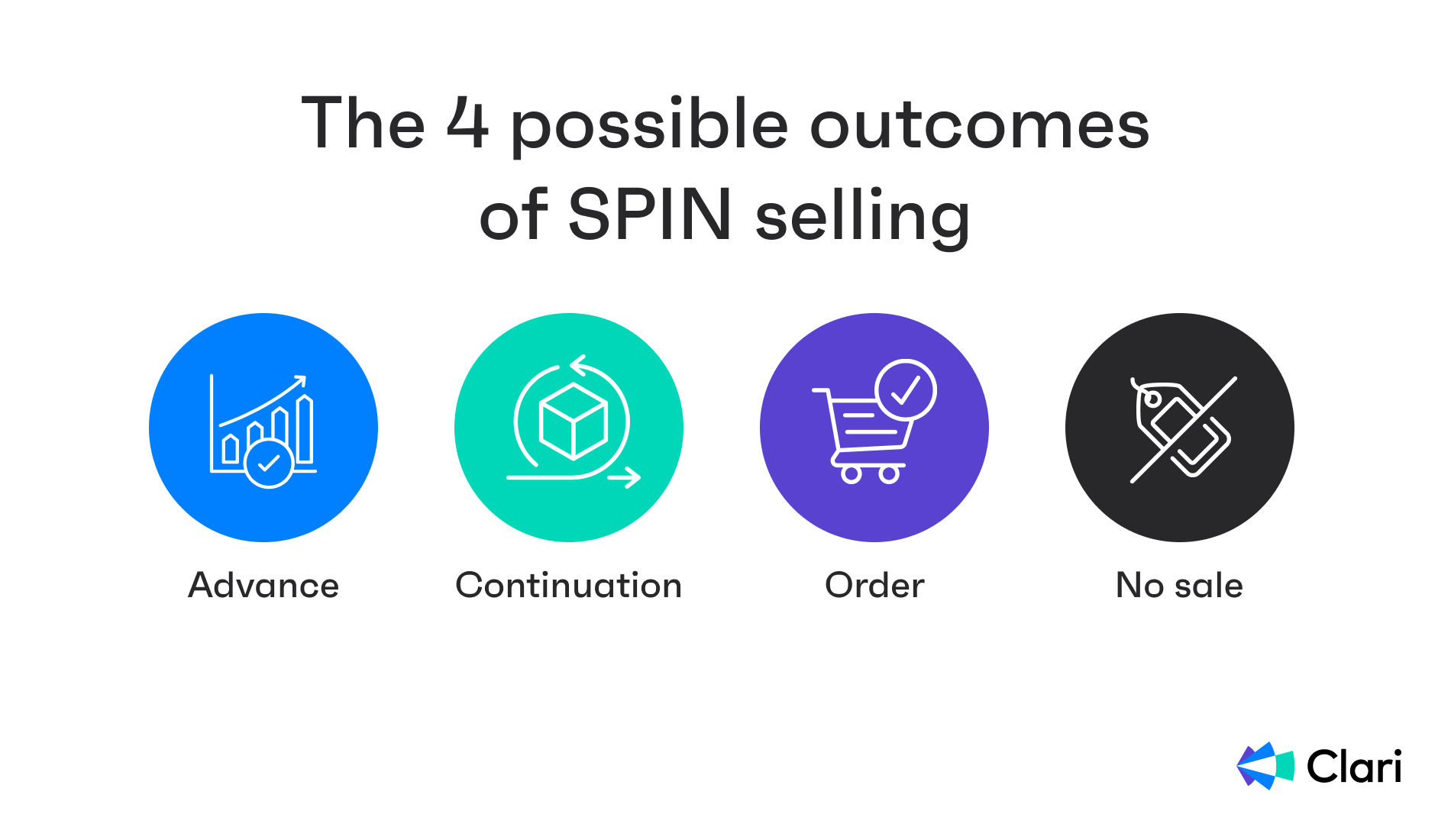
Here’s what they mean and how your sales teams should respond.
Advance
An advance is a buyer commitment that brings you closer to a sale. You can get an advance by encouraging the prospect to take action. This can include:
- Sending questions
- Signing up for a demo
- Looping in a decision-maker
It doesn’t matter how big or small your advance is or what level of commitment it takes. Even the smallest advances can ultimately end in a close deal.
Continuation
A continuation is an undesirable end to a sales conversation and typically occurs when a prospect doesn’t agree to the next step you suggest.
Receiving a continuation isn’t the end of the world, however. With the right follow-up strategy, you could turn almost any continuation into an advance.
Order
The prospect agrees to a purchase and shows their desire by completing paperwork. This is the most successful outcome and is the SPIN Selling equivalent of a closed deal.
You probably won’t get an order after your first conversation, especially if you work in B2B sales. But don’t be discouraged. If the prospect doesn’t say no, you’re still in with a shot.
No sale
This is the least desirable outcome, and it’s pretty self-explanatory. It occurs when the prospect clarifies that they aren’t interested in your product.
Even the SPIN methodology can’t close every deal, so don’t be too downhearted. After all, it may not be your fault if your product wasn’t a good fit.
When is SPIN selling the right framework for your business?
Like with most complicated questions, the short answer here would be “It depends.” It depends on your market, your target persona, your product, your market goodwill, and a host of other features. However, a look at the building blocks of SPIN selling shows that it’s basically about taking time to generate trust. That’s what’s at the core. The rest are just guidelines to make that process easy.
Naturally, in case of quick transactional sales where the prospect is actually further along the funnel and is ready to close the deal from their end, SPIN selling is unnecessary and may even be counterproductive due to the time commitment.
In contrast, B2B mid-market and enterprise sales often involve an intricate cycle of multiple decision-makers. For you to navigate the waters of a complex sales environment, building up strong buyer-seller relationships is key. Here, SPIN selling would be perfect since establishing trust is more important than making a quick sale.
How Clari Copilot helps you implement SPIN sales
Technology is your friend when it comes to implementing SPIN selling successfully. Here’s how we can help:
- From recording conversations to analyzing your sales calls, Clari Copilot offers an easy and efficient alternative to take care of your end-to-end SPIN sales interaction.
- Thanks to Clari Copilot’s sales acceleration stack and insights like talk/listen to ratio, longest monologues, and the number of pertinent questions asked, you get a complete analysis of your sales reps’ conversations with prospects.
- Analyze call transcripts and coach your reps for sales success, aka Topics Tracking.
You can also:
- Pull out insights on a prospect’s likelihood of conversion, roadblocks, and other purchasing decisions.
- Review the performance of your sales professionals with the Team Dashboard.
So who’s ready to SPIN and win? Book a demo today!


